Linear motor
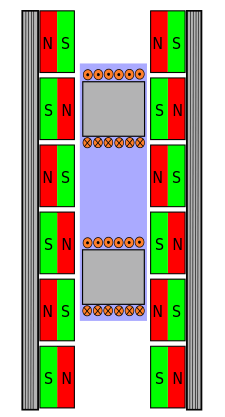
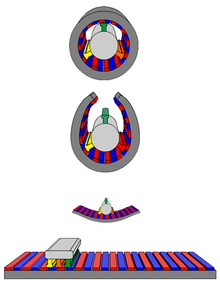
A linear motor is an electric motor that has had its stator and rotor "unrolled" so that instead of producing a torque (rotation) it produces a linear force along its length. However, linear motors are not necessarily straight. Characteristically, a linear motor's active section has ends, whereas more conventional motors are arranged as a continuous loop.
The most common mode of operation is as a Lorentz-type actuator, in which the applied force is linearly proportional to the current and the magnetic field .
Many designs have been put forward for linear motors, falling into two major categories, low-acceleration and high-acceleration linear motors. Low-acceleration linear motors are suitable for maglev trains and other ground-based transportation applications. High-acceleration linear motors are normally rather short, and are designed to accelerate an object to a very high speed, for example see the coilgun.
High-acceleration linear motors are typically used in studies of hypervelocity collisions, as weapons, or as mass drivers for spacecraft propulsion . They are usually of the AC linear induction motor (LIM) design with an active three-phase winding on one side of the air-gap and a passive conductor plate on the other side. However, the direct current homopolar linear motor railgun is another high acceleration linear motor design. The low-acceleration, high speed and high power motors are usually of the linear synchronous motor (LSM) design, with an active winding on one side of the air-gap and an array of alternate-pole magnets on the other side. These magnets can be permanent magnets or energized magnets. The Shanghai Transrapid motor is an LSM.
Types
Synchronous
In this design the rate of movement of the magnetic field is controlled, usually electronically, to track the motion of the rotor. For cost reasons synchronous linear motors rarely use commutators, so the rotor often contains permanent magnets, or soft iron. Examples include coilguns and the motors used on some maglev systems, as well as many other linear motors.
Induction
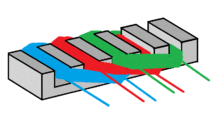
In this design, the force is produced by a moving linear magnetic field acting on conductors in the field. Any conductor, be it a loop, a coil or simply a piece of plate metal, that is placed in this field will have eddy currents induced in it thus creating an opposing magnetic field, in accordance with Lenz's law. The two opposing fields will repel each other, thus creating motion as the magnetic field sweeps through the metal.
Homopolar
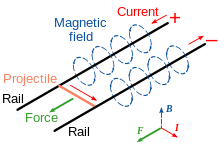
In this design a large current is passed through a metal sabot across sliding contacts that are fed from two rails. The magnetic field this generates causes the metal to be projected along the rails.
Piezo electric
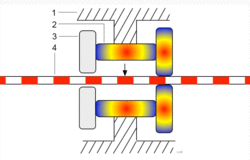
Piezoelectric drive is often used to drive small linear motors.
History

Low acceleration
The history of linear electric motors can be traced back at least as far as the 1840s, to the work of Charles Wheatstone at King's College in London,[1] but Wheatstone's model was too inefficient to be practical. A feasible linear induction motor is described in the U.S. Patent 782,312 (1905 - inventor Alfred Zehden of Frankfurt-am-Main), for driving trains or lifts. The German engineer Hermann Kemper built a working model in 1935.[2] In the late 1940s, Dr. Eric Laithwaite of Manchester University, later Professor of Heavy Electrical Engineering at Imperial College in London developed the first full-size working model. In a single sided version the magnetic repulsion forces the conductor away from the stator, levitating it, and carrying it along in the direction of the moving magnetic field. He called the later versions of it magnetic river.
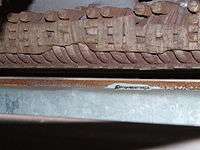
Because of these properties, linear motors are often used in maglev propulsion, as in the Japanese Linimo magnetic levitation train line near Nagoya. However, linear motors have been used independently of magnetic levitation, as in Bombardier's Advanced Rapid Transit systems worldwide and a number of modern Japanese subways, including Tokyo's Toei Oedo Line.
Similar technology is also used in some roller coasters with modifications but, at present, is still impractical on street running trams, although this, in theory, could be done by burying it in a slotted conduit.
Outside of public transportation, vertical linear motors have been proposed as lifting mechanisms in deep mines, and the use of linear motors is growing in motion control applications. They are also often used on sliding doors, such as those of low floor trams such as the Citadis and the Eurotram. Dual axis linear motors also exist. These specialized devices have been used to provide direct X-Y motion for precision laser cutting of cloth and sheet metal, automated drafting, and cable forming. Most linear motors in use are LIM (linear induction motor), or LSM (linear synchronous motor). Linear DC motors are not used due to higher cost and linear SRM suffers from poor thrust. So for long run in traction LIM is mostly preferred and for short run LSM is mostly preferred.
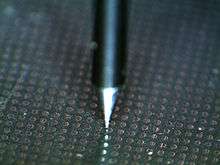
High acceleration
High-acceleration linear motors have been suggested for a number of uses. They have been considered for use as weapons, since current armour-piercing ammunition tends to consist of small rounds with very high kinetic energy, for which just such motors are suitable. Many amusement park roller coasters now use linear induction motors to propel the train at a high speed, as an alternative to using a lift hill. The United States Navy is also using linear induction motors in the Electromagnetic Aircraft Launch System that will replace traditional steam catapults on future aircraft carriers. They have also been suggested for use in spacecraft propulsion. In this context they are usually called mass drivers. The simplest way to use mass drivers for spacecraft propulsion would be to build a large mass driver that can accelerate cargo up to escape velocity, though RLV launch assist like StarTram to low earth orbit has also been investigated.
High-acceleration linear motors are difficult to design for a number of reasons. They require large amounts of energy in very short periods of time. One rocket launcher design[3] calls for 300 GJ for each launch in the space of less than a second. Normal electrical generators are not designed for this kind of load, but short-term electrical energy storage methods can be used. Capacitors are bulky and expensive but can supply large amounts of energy quickly. Homopolar generators can be used to convert the kinetic energy of a flywheel into electric energy very rapidly. High-acceleration linear motors also require very strong magnetic fields; in fact, the magnetic fields are often too strong to permit the use of superconductors. However, with careful design, this need not be a major problem.[4]
Two different basic designs have been invented for high-acceleration linear motors: railguns and coilguns.
Usage
Linear motors are widely used. One of the major uses of linear motors is for propelling the shuttle in looms.
Linear motors have been used for sliding doors and various similar actuators. Also, they have been used for baggage handing and can even drive large-scale bulk materials transport solutions.
Linear motors are sometimes used to create rotary motion, for example, they have been used at observatories to deal with the large radius of curvature.
A linear motor has been used for accelerating cars for crash tests.[5]
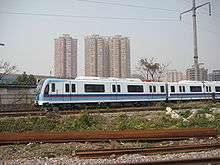
Train propulsion
Conventional rails
All applications are in rapid transit.
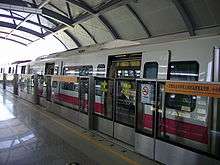
- Bombardier ART:
- Airport Express in Beijing (opened 2008)
- AirTrain JFK in New York (opened 2003)
- Detroit People Mover in Detroit (using ICTS) opened 1987
- EverLine Rapid Transit System in Yongin (opened 2013)
- Kelana Jaya Line in Kuala Lumpur (opened 1998)
- Scarborough RT in Toronto (using UTDC's (predecessor) ICTS technology - opened 1985)
- UTDC ICTS test track in Millhaven, Ontario
- SkyTrain in Vancouver (Expo Line (using ITCS) opened 1985 and Millennium Line opened in 2002)
- Several subways in Japan and China, built by Kawasaki Heavy Industries:
- Limtrain in Saitama (short-lived demonstration track, 1988)
- Nagahori Tsurumi-ryokuchi Line in Osaka (opened 1990)
- Toei Ōedo Line in Tokyo (opened 2000)
- Kaigan Line in Kobe (opened 2001)
- Nanakuma Line in Fukuoka (opened 2005)
- Imazatosuji Line in Osaka (opened 2006)
- Green Line in Yokohama (opened 2008)
- Sendai Subway Tōzai Line in Sendai, Japan (opened 2015)
- Line 4 of Guangzhou Metro in Guangzhou, China (opened 2005).[6]
- Line 5 of Guangzhou Metro in Guangzhou, China (open in December 2009).
- Line 6 of Guangzhou Metro in Guangzhou, China (open in December 2013).
Both the Kawasaki trains and Bombardier's ART have the active part of the motor in the cars and use overhead wires (Japanese subways[7][8]) or a third rail (ART[9]) to transfer power to the train.
Monorail
- There is at least one known monorail system which is not magnetically levitated, but nonetheless uses linear motors. This is the Moscow Monorail. Originally, traditional motors and wheels were to be used. However, it was discovered during test runs that the proposed motors and wheels would fail to provide adequate traction under some conditions, for example, when ice appeared on the rail. Hence, wheels are still used, but the trains use linear motors to accelerate and slow down. This is possibly the only use of such a combination, due to the lack of such requirements for other train systems.
- The TELMAGV is a prototype of a monorail system that is also not magnetically levitated but uses linear motors.
Magnetic levitation
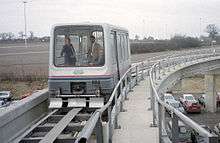
- High-speed trains:
- Transrapid: first commercial use in Shanghai (opened in 2004)
- SCMaglev, under test in Japan
- Rapid transit:
- Birmingham Airport, UK (opened 1984, closed 1995)
- M-Bahn in Berlin, Germany (opened in 1989, closed in 1991)
- Daejeon EXPO, Korea (ran only 1993)[10]
- HSST: Linimo line in Aichi Prefecture, Japan (opened 2005)
- Incheon Airport Maglev (opened July 2014)
Amusement rides
There are many roller coasters throughout the world that use LIMs to accelerate the ride vehicles. The first being Flight of Fear at Kings Island and Kings Dominion. Both opened in 1996.
e.g.:
- Blue Fire - Where the LSM accelerates the train from 0 to 100 km/h in 2.5 s.
- California Screamin' - Roller coaster LIM application
- Maverick - A roller coaster LSM application
- Tomorrowland Transit Authority - Slow ride LIM application
- Dreamworld, Australia - LSM reverse freefall roller coaster
- Rock 'n' Roller Coaster Starring Aerosmith - LSM accelerated rollercoaster
- Battlestar Galactica: Human vs. Cylon - LSM accelerated inverted & seated rollercoaster
Aircraft Launching
Proposed & research
- Launch loop - A proposed system for launching vehicles into space using a linear motor powered loop
- StarTram - Concept for a linear motor on extreme scale
- Tether cable catapult system
- Research Test Vehicle 31 - A hovercraft-type vehicle guided by a track
- Hyperloop - a conceptual high-speed transportation system put forward by entrepreneur Elon Musk
- Elevator "ThyssenKrupp Elevator: ThyssenKrupp develops the world's first rope-free elevator system to enable the building industry face the challenges of global urbanization:". Retrieved 2015-06-02.
- Lift "Technology: Linear Synchronous Motor Elevators Become a Reality". Retrieved 2015-06-02.
See also
- Linear actuator
- Maglev
- Online Electric Vehicle
- Reciprocating electric motor
- Sawyer motor
- Tubular linear motor
References
- ↑ "Charles Wheatstone - College History - King's College London". Kcl.ac.uk. Retrieved 2010-03-01.
- ↑ http://cem.colorado.edu/archives/fl1997/thor.html
- ↑ "Magnetic Materials - Electromagnetic Guns". coilgun.info. Retrieved 2014-11-22.
- ↑ Yen, F.; Li, J.; Zheng, S. J.; Liu, L.; Ma, G. T.; Wang, J. S.; Wang, S. Y. (2010). "A single-sided linear synchronous motor with a high temperature superconducting coil as the excitation system". Superconductor Science and Technology. 23: 105015. doi:10.1088/0953-2048/23/10/105015.
- ↑ Popular Science. Bonnier Corporation. p. 64. ISSN 0161-7370.
- ↑ "> Asia > China > Guangzhou Metro". UrbanRail.Net. Retrieved 2010-03-01.
- ↑ "Adoption of Linear Motor Propulsion System for Subway". Home.inet-osaka.or.jp. Retrieved 2010-03-01.
- ↑ Archived July 8, 2008, at the Wayback Machine.
- ↑ "The Scarborough Rapid Transit Line - Transit Toronto - Content". Transit Toronto. November 10, 2006. Retrieved 2010-03-01.
- ↑ "The International Maglevboard". Maglev.de. Retrieved 2010-03-01.
External links
| Wikimedia Commons has media related to Linear motors. |
- Design equations, spreadsheet, and drawings
- Motor torque calculation
- Overview of Electromagnetic Guns
- Voice Coil Actuators